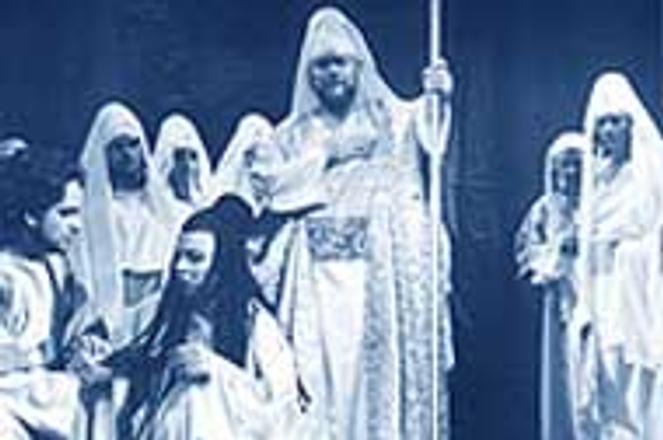Peter Mikuláš as Zaccaria and Denisa Šlepkovská as Fenenaxfoto: K. Marenčinová
Nabucco
Next performance: Friday March 17, 2000
Tickets: 50-250 Sk
Starts at: 19.00
Venue: Slovak National Theatre.
Tel: 5443 3083
The epic tale of Nabucco, set in Jerusalem and Babylon in 586 B.C., unfolded on the stage of the Slovak National Opera House on February 18. Judging by the rousing reaction of the predominantly Austrian crowd, the ancient tale will draw more opera enthusiasts (and novices) to future performances.
Nabucco is an extremely well choreographed and beautifully performed performance. The collective voice of the choir is stunning, the soloists reach seemingly impossible notes and the stage-arrangements and costumes are outstanding.
Yet, as grandiose as the historic tale is, the stage-arrangements are diminutive in proportion. The contrast is quite effective in its simplicity as the backdrop does not distract the viewer from the musical drama.
The show hits the ground running as the Hebrews wail in despair at having been conquered by the armies of Nabucco, the King of Babylon. Nabucco, played by Sergej Tolstov, rivets viewers with the strength of his voice as he celebrates his troop's hard fought victory.
Other characters emerge with the plot. Zachary (played by Ján Galla) storms on stage after he captures the enemy king's daughter Fenena (played by Jitka Sapara-Fisherova).
Tenor Otto Klein convincingly portrays Ismaele, the unfortunate nephew of the King of Jerusalem. Having fallen in love with Fenena, the daughter of an enemy soldier, Ismaele must grapple with the tormenting question of which allegiance will prove stronger to his sick heart.
One of the more forgettable characters was the slave-girl Abigail. Played by Magdaléna Blahušiaková, she is overshadowed by Lubica Vargicová who plays a smaller role but has a lovelier and more powerful voice far more capable of moving a crowd.
The most impressive aspect of the performance is the scenery and the costumes. Set designer and director Zuzana Lacková initially uses sand colours later mixed with bright red and blue creating a contrast which effectively highlights the drama of the opera. The use of warrior silhouettes behind the coulisse and the uncluttered stage also aids the performance by subtly enhancing the singers and their tale, without becoming an overbearing presence. Finally, the costumes are designed in a way which is faithful to history yet manage to be innovative and modern.
The performance maintains its intensity throughout the third and the fourth acts. When Fenena converts to the enemy's religion, the choir sings the stunning hymn "Va pensiero" in a dramatic climbing crescendo.
The choreography is also worthy of mention. Ballet-dancer Jozef Dolinský has created a beautiful and uncluttered impression of the historic tale, manoeuvring his singers in sweeping waves on the stage.


